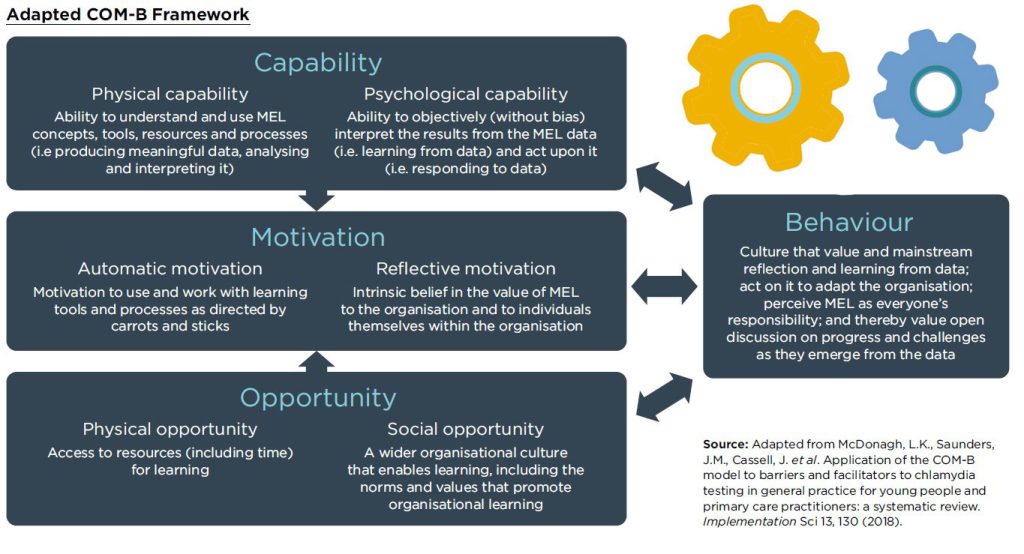To Build a Learning Culture, Think beyond MEL Trainings: Think Behavior Change Strategies
By Loïc Watine, Julie Bélanger, and Joachim Krapels
Think about the last training session you attended on Monitoring, Evaluation, and Learning (MEL). Now, how are you using it today? We are willing to take a bet that you are not using much of it beyond a few insights, at most perhaps you have adopted a few practices. Unfortunately, most knowledge and skills gained through trainings evaporate relatively quickly. And there is no reason to assume MEL training for organizational learning does any better. As MEL people, we should take this seriously and rethink how we help organizations to start learning.
Organizational learning is in essence a behavioral shift and needs to be addressed as such. Existing models of behavioral change can therefore help us to better understand this difficult shift in organizations. In a new article published in Alliance Magazine, we have applied a well-known behavioral framework, the COM-B model, to organizational learning as a way to organize the insights we’ve gained on this topic over the last few years, and to dig deeper into what it takes to bring it about. In short, this framework stipulates that behavior is influenced by: Capability, Opportunity, and Motivation. For our purposes, the idea is that creating a learning organization implies targeting not only capabilities within the organizations but also creating opportunities for learning to happen and building motivation among staff members.

Applying that lens to our experiences and past efforts around building organizational learning cultures brought us a number of insights. You’ll have to read the article for the complete list, but here are a few concrete examples—one for each element of the COM-B model:
- Capability: the capabilities required to really learn are as much about doing new things as they are about overcoming deep-rooted biases. Confirmation bias, resistance to change, positivity bias, and others can lead us to misinterpret data or even inhibit us from seeking evidence in the first place. Directly targeting biases may be an overlooked area in strengthening organizational learning capacities.
- Opportunity: Creating the opportunities for MEL behaviors to take place is critical, and this means allocating resources to it. We find that a common challenge is related to budgeting for MEL on projects or initiatives. Agreeing on rules of thumb (e.g. 5 percent of the budget should be for MEL) can be helpful in protecting what often first gets cut in the design stage. But it’s even better if those rules of thumbs take into account the level of maturity of the program: while even 2 percent might be enough in the context of a proven program operating at a very large scale, the optimal MEL spending for a small-scale innovative pilot, where learning ought to be the primary goal, could well be over 30 percent of the total budget.
- Motivation: A major challenge we see is that existing incentive structures usually lead people to be more inclined to make something “look” successful than to engage in deep iterative learning. We find that framing project goals around really understanding and solving problems can help to create the space to continually question how we can achieve real sustainable impact. This means that instead of simply re-purposing an intervention that has been used in other contexts, we take the time to clearly define the problem we are trying to solve, digging into its root causes, in order to design bespoke solutions that specifically target those root causes.
As MEL people we have a tendency to think about technical training (capability) as the solution to help our organizations be better at learning. That clearly isn’t sufficient to create meaningful and durable organizational change—organizational leaders (with support from MEL teams) also need to create an enabling environment that encourages learning (opportunity), and to get teams genuinely interested and invested in it (motivation). Clearly, that is easier said than done, but we hope that the article will provide a few ideas for how to do that in practice. Let us know in the comments below if you think of others!
Loïc Watine is the Director of Right Fit Evidence Advisory Unit at Innovations for Poverty Action. Julie Bélanger is the Director at Better Purpose. Joachim Krapels is the Chief Science Officer of the Effective Philanthropy Group at Porticus.











